Day of the Dead: A complete guide to the most colorful, bizarre and interesting of Mexican celebrations.
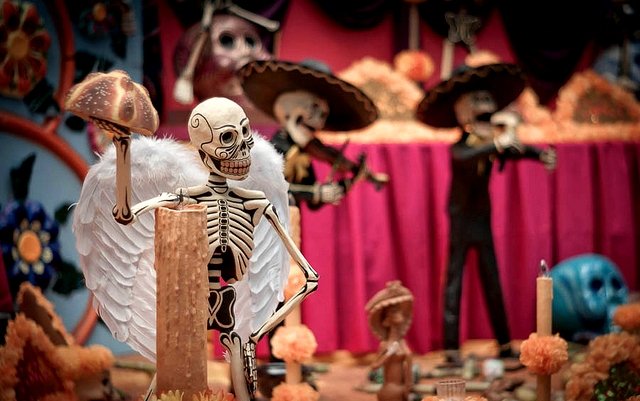
Bone and skeleton-shaped food? Picnics in the cemetery? People eagerly awaiting for the dead to return? For Mexican people, it's all happening next week, during the day of the dead celebration taking place each year between November 1st and 2nd.
An extravagant explosion of colors and folklore, Day of the Dead is now all the rage in the mainstream popular culture, from the ubiquitous and unmistakable sugar skull designs, to the go-to Halloween costume of your average blogger girl:
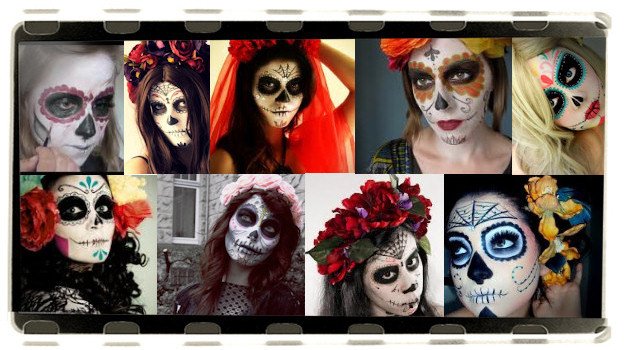
Even Pixar is now capitalizing on it with its new animated film, Coco (which by the way, gets my Mexican seal of approval regarding authenticity judging by the visual aspect of the trailer):
The altar for the dead.
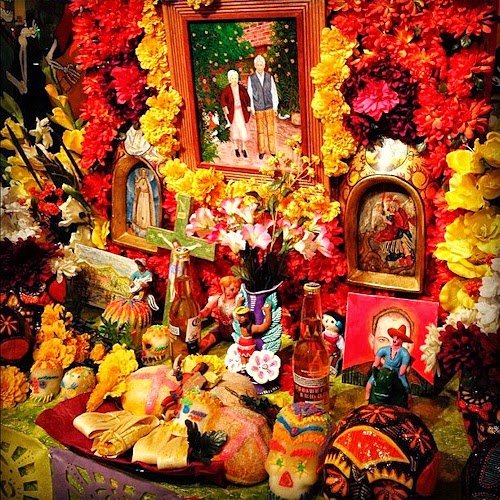
The central piece of the Day of the Dead celebration at home is an altar or shrine dedicated to the dead; it may sound a bit macabre at first, but in reality is done with a cheerful edge in loving commemoration of those who are no longer among us.
The whole concept behind the festivity is that, for one day only, the spirits of the dead are allowed to step back into the realm of the living to visit their families and enjoy the offerings presented for them in these altars.
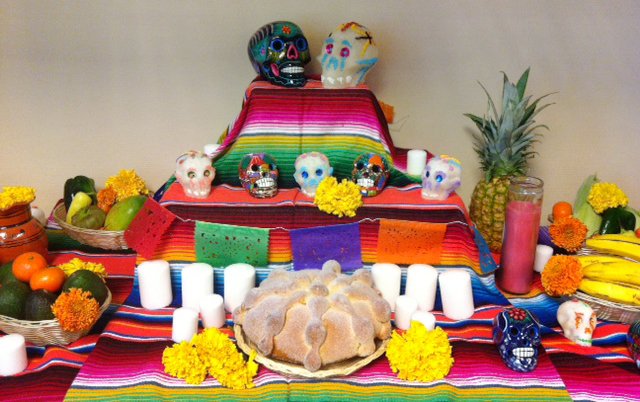
The altar is a special place in which one places all the items and food that will be offered in remembrance of the deceased ones, and it can be as big or small, as simple or extravagant as one wants.
I usually set up a small table in the dining room or the main living room, since that way the altar is on display both for family and visitors. That’s another thing I enjoy very much about this time of the year: going to other people’s houses and looking at their altars! Some of them are so creative and lovingly made.
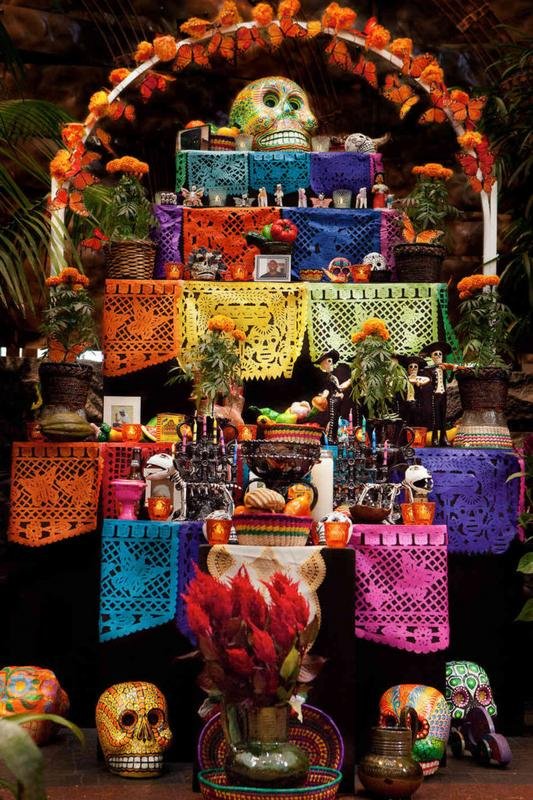
To me, nothing announces the upcoming Day of the Dead celebrations in Mexico as the unmistakable aroma of Mexican marigolds scenting the air when one walks past a market.
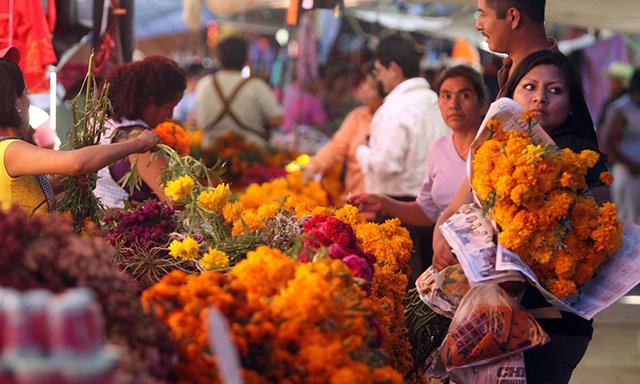
Marigolds are used because they are supposed to attract the souls of the dead; we call them by their old name in Náhuatl tongue: Cempazúchitl or Cempasúchil.
One tradition that I like to follow is adding a little trail of marigold petals leading from the front door of the house to the altar; it is believed that this will help the soul of the visiting dead to find the offering.
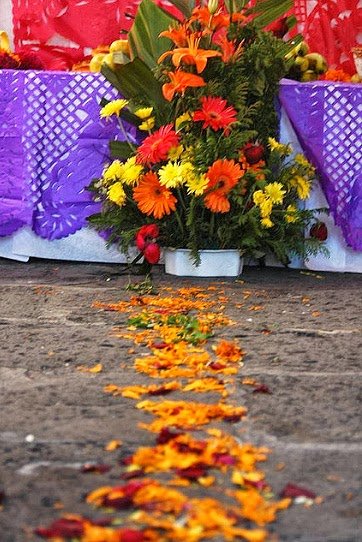
That is one interesting thing about folk knowledge regarding the dead in Mexico: curiously, the sense of smell seems to be the most important to them, as can be inferred by the emphasis on the aromas during this celebration. Thus, the smell of the marigold serves as a guiding path.
Food for the dead.
Beyond the decorative elements, the main part of the offering is the food. Traditional dishes like mole, tamales, candied pumpkin or chiles en nogada are usually added (according to the personal preferences of the deceased loved ones being commemorated), but there is also food that is unique for this celebration.
Pan de muerto is a kind of sweet bread with a subtle but aromatic orange flavor and a touch of anis essence that is only produced around this time of the year.
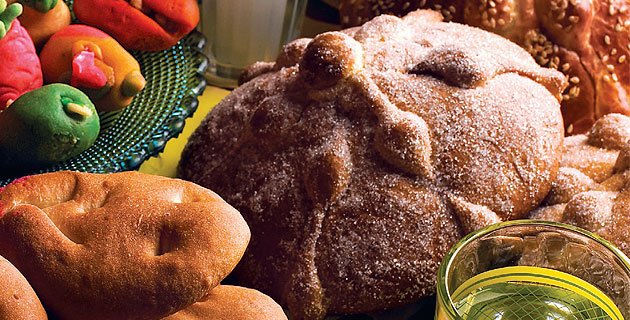
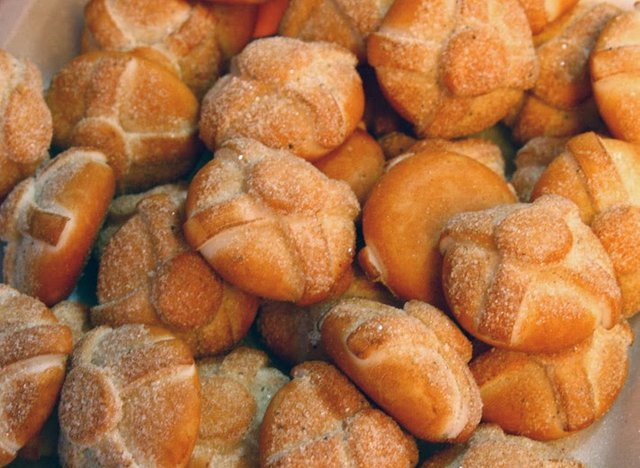
Another example is jamoncillo, which are sweets made out of ground and sweetened nuts or seeds: pumpkin seeds (the most common sort), almond and/or pine nuts (which are the most expensive and exquisite ones). They are very much like marzipan. The paste is then tinted with bright, bold vegetable colors and the figurines are confected. Animals, fruit, food and even certain objects are among the popular depictions.
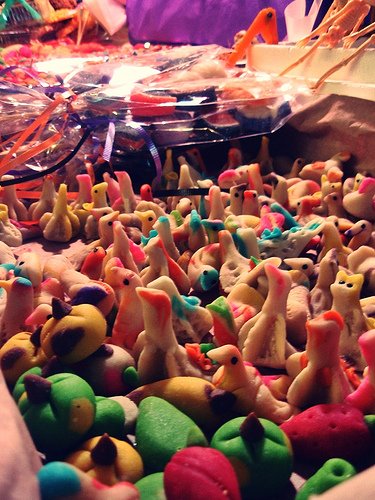
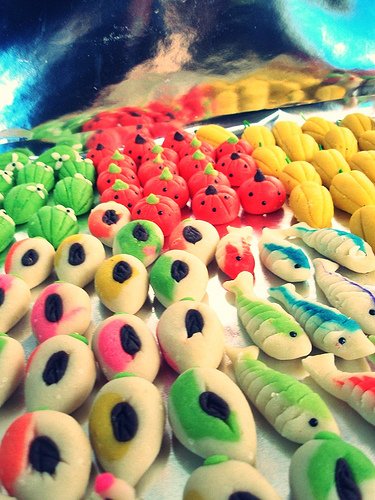
The most iconic element in the Day of the Dead celebration, is definitely the sugar skull: a white cranium decorated with multicolored icing details, often sporting a metallic paper ‘headdress’ and usually bearing the name of one of the deceased loved ones being commemorated. While there is a standard basic design, the variations on color and decoration are endless; also, sugar is not the only ingredient they can be made of –chocolate, amaranth seeds and even gummy or candied fruit skulls are also popular and can be found at the markets.
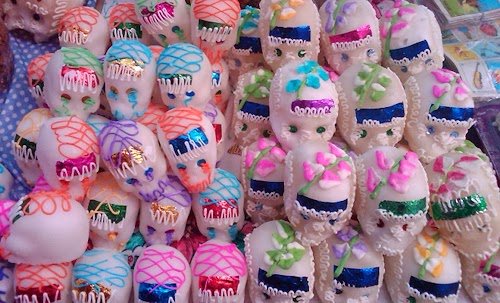
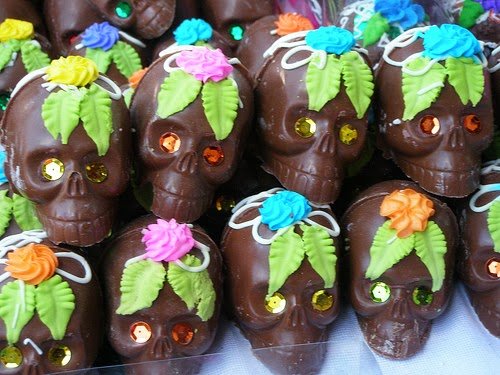
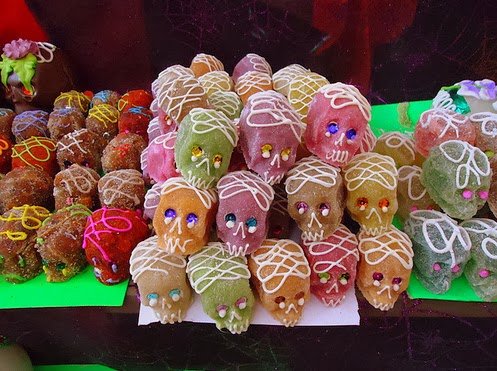
Following the aromatic theme, another practice employed to attract the spirits of the dead is burning incense. Ideally, it must be copal incense, sold in pieces made from hardened tree resin that are to be burnt in a special clay or metallic burner. This is the kind of incense that has been used in traditional ceremonies for thousands of years, the one used in ancient, pre-Hispanic Mexico.
One can add photos, pictures, toys, favorite items of the deceased, and anything that the people to whom the altar is dedicated used to enjoy in life. Almost anything goes, so creativity can be let loose here as well. However, I find that the altar looks better when it’s not overpowered by non-traditional elements.
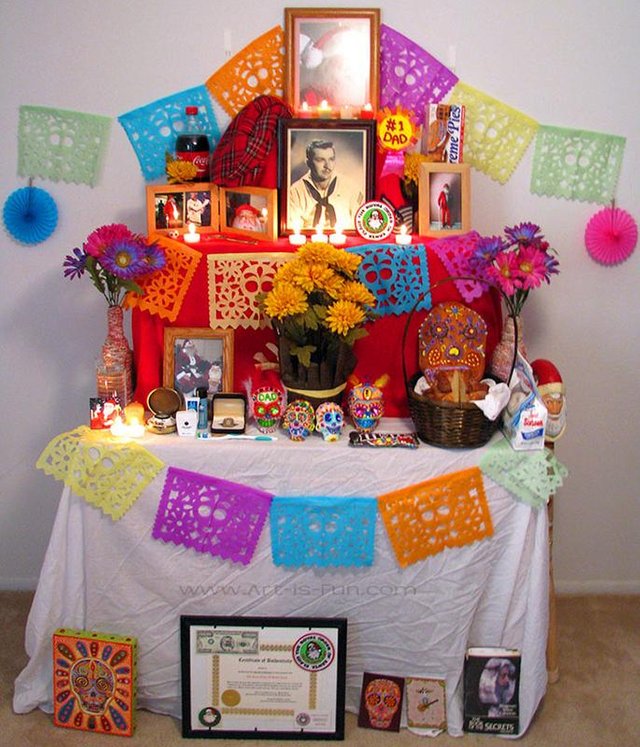
The Celebration.
A visit to the Cemetery.
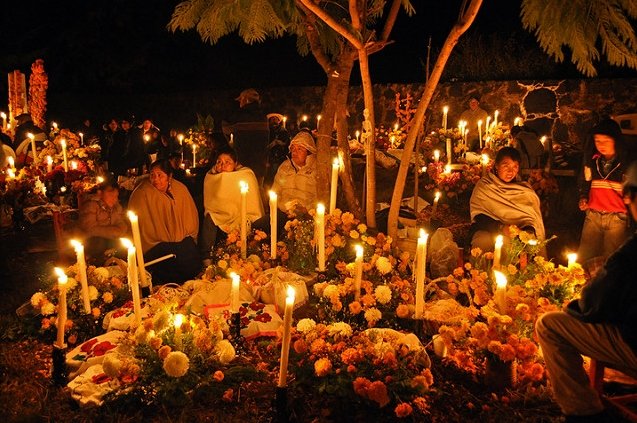
The most traditional thing to do, and the most meaningful, is to go to the cemetery to visit the graves of deceased family members and friends who are being commemorated on this day.
People bring flowers –predominantly the typical Mexican marigold– and clean the graves; also, some people like to bring food (the same kind one puts on the altar) and make a sort of picnic around the grave, lighting candles and incense for the souls of the dead.
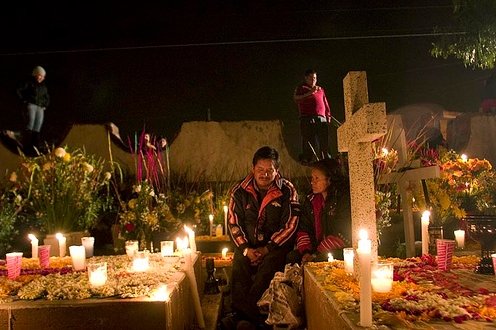
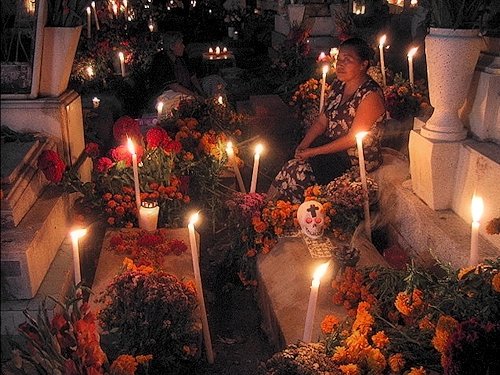
In small, picturesque traditional towns –denominated by the Mexican government as Magical Towns, no joke– the visit to the cemetery is usually done by night and turns into a spectacular event: the whole field transforms into a sea of lit candles, the smell of incense and marigold scenting the air, and musicians playing traditional songs to serenade the dead, while families gather around the graves to eat bread and tamales and drink café de olla – coffee prepared in a clay vessel with a touch of cinnamon and sweetened with unprocessed cane sugar.
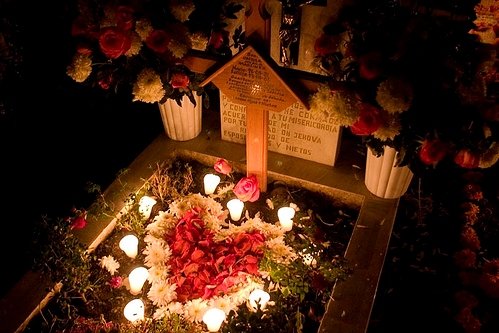
Some even install altars on the graves, a worthy effort since the celebration goes on all night. I can assure that witnessing all of this is an unforgettable experience and one you should plan on partake if you happen to travel to Mexico during these days.
(Source for all the cemetery pictures, here.)
Coffee and Hot Chocolate at Home.
While visiting the cemetery is the most traditional thing to do, many other people just celebrate by having a get-together and chatting over a cup of coffee or hot chocolate, while indulging on some Day of the Dead bread.
This is the popular way to celebrate among the younger generations; in fact, most workplaces and schools organize small gatherings like these on November 2nd. Many families celebrate at home like this as well, having a relaxed chat that centers on remembering the dead relatives.
Watch an ad hoc film: Macario (1960).
Each holiday comes with its associated seasonal movie reflecting the spirit of the festivity – like A Christmas Carol (or my favorite movie to watch on Christmas: Edward Scissorhands). Day of the Dead is not the exception, for every year one can expect multiple screenings of the movie associated with it: Macario.
Macario is a Mexican film from 1960 – from a period known as “The Golden Era of Mexican Cinema”– that takes place in a small town during the Day of the Dead festivities in the colonial times (late 18th and early 19th century).
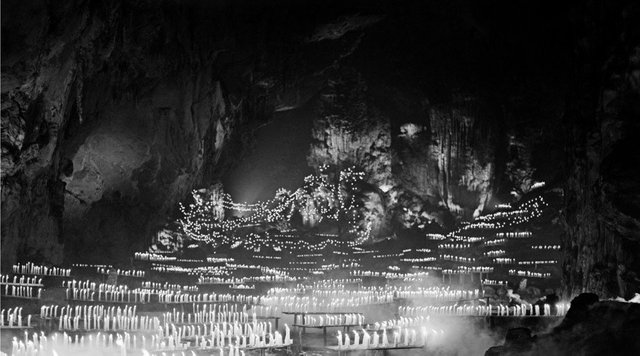
Macario is a country man of Indian lineage, head of a big family who are perpetually hungry due to their extreme poverty; he finds himself so disappointed with his life, which has been always defined by lacking and sacrifice, that he becomes obsessed with the idea of being able to eat an entire turkey by himself, without sharing it with anyone; that represents his ultimate dream of having something that is only his own.
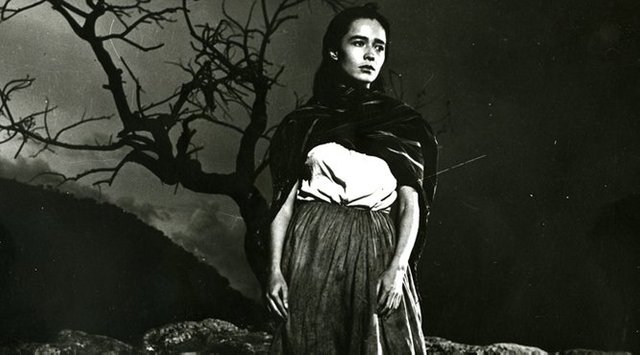
When Macario finds himself in the position to finally make his dream come true, he has encounters with the Devil, God and Death –embodied as a somber, starved-looking man–, all of which ask him to share the turkey with them by appealing to different aspects of his psyche. Macario takes his decision and it alters his life and his family’s forever.
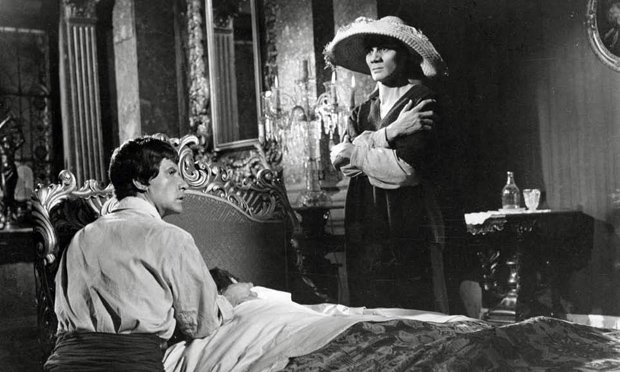
Writing and exchanging Calaveras.
During Day of the Dead, some people write verses called Calaveras (Spanish term for human skulls).
Calaveras being sort of short poems written about someone, which are meant to be humorous and a bit cheeky. It is important to note that Calaveras are written about a living person in a playful way as if they were dead, not about the dead themselves.
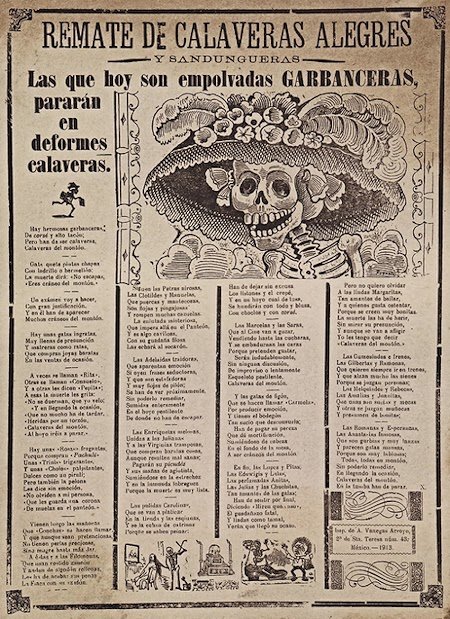
Traditionally, they are formulaic and typically go like this: they talk about a person’s character or distinguishing feature in a way, then Death –embodied as a skeleton or calaca– appears before them and tells them their time has come, then the living person tries to get himself out of the situation, but usually in the end Death ends up outsmarting them and taking them with her anyway.
It is supposed to be a facetious, light hearted practice, and some people do friendly exchanges of them to celebrate Day of the Dead.
On November 2nd, most newspapers publish a special supplement with Day of the Dead themed cartoons and Calaveras written about politicians, actors and entertainers, celebrities and public figures, commonly taking the chance to use humor as a vehicle for social or personal criticism about them or their actions and performance.
What happens at the end of the celebration?
The altar must be kept intact until November 2nd in the afternoon. If possible, the candles should burn overnight from the night of the 1st until the morning of the 2nd. Close to midday, one should light a candle and some incense for the lone souls – those who don’t have any living relatives or friends to place an offering for them; it is thought that the light and smell of copal incense comforts them.
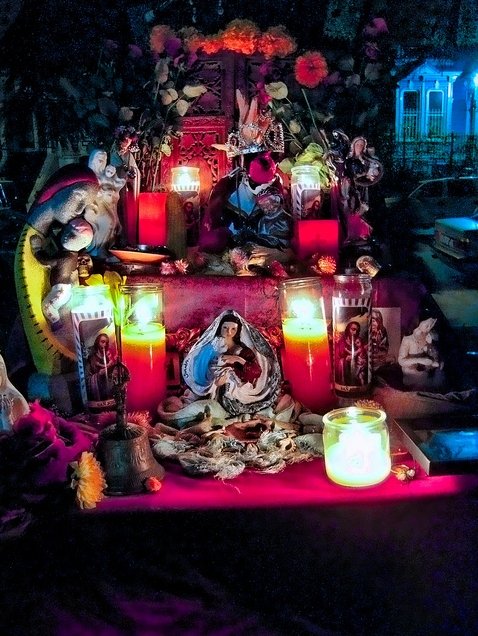
On the afternoon of the 2nd, my grandmother would usually shout “now you are free to eat out of the offering!”. The food is not to be touched until then! Otherwise, according to my grandma, the dead will come to your room in the night and pull your feet (if you have seen The Conjuring, you know you don’t want that to happen).
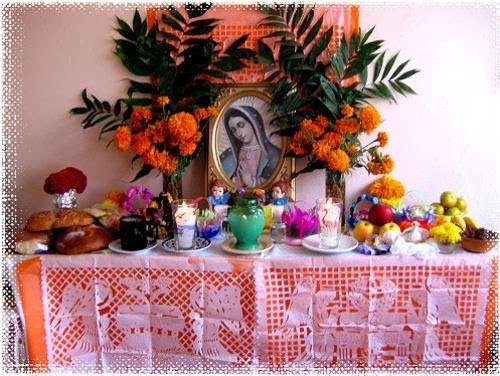
Normally, the only edible food at the end are the sweets and the fruit, since the savory dishes usually go off and the bread gets hard and dry from being left outside (one can still eat it by dipping it in hot chocolate or coffee, though).

Even though it is my favorite Mexican celebration, due to my nomadic lifestyle I have now missed out on it for about 7-8 years in a row. However, sharing it with you helps me to feel closer to my culture and happy to still rejoice and take part in this beautiful folklore. I hope you found it interesting!
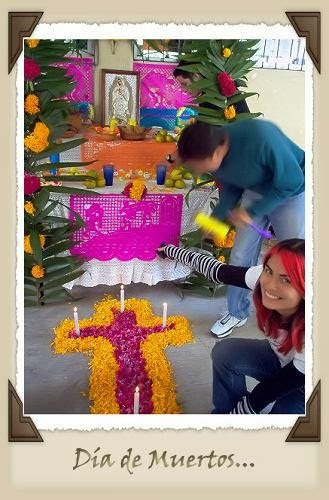
Cool idea / Great post / Resteemed (-:
Thank you very much! :-)
Spectacular...!
It would be really great to attend this celebration once in my lifetime! Great post and very well written!
May I also recommend a film btw?? Although it has little to do with the day of the dead I remember an animated film from Guillermo Del Toro called The book of Life. Many of the figures in your photos remind me of this film :)
Thank you for sharing!!!!
The main celebration of Day of the Dead is one of those things that one has to witness in person, indeed!
I just watched the trailer and you are right, it looks very similar, although I have to say it looks somehow like they made everything more Spanish-looking for some reason and took quite a lot of artistic liberties with the designs... this new Coco film looks a lot closer to the real thing I would say.
Thanks a lot for such nice feedback, @theodorelib!
Glad to see another good post.
very beautiful masks!
This post has received a 6.51 % upvote from @booster thanks to: @irime.
That's great! I want to try some of that pan de muerto.
@altherion it is one of my favorite foods, no joke! Just love the subtle orange/anise flavor...